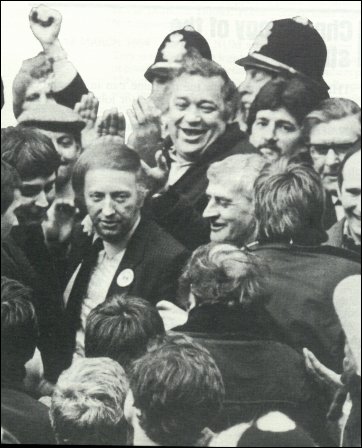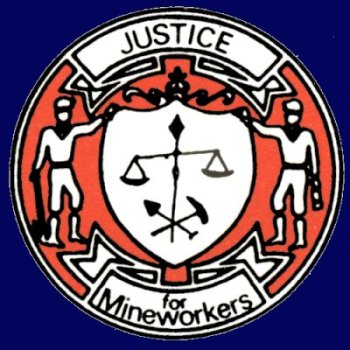 |
| Scargill
and lobby after NUM executive meeting in Sheffield 8th March 1984. Photo: John
Sturrock/Network |
 |
| Scargill
and lobby after NUM executive meeting in Sheffield 8th March 1984. Photo: John
Sturrock/Network |
 |
 | ||
| NUM Hijacked FOLLOWING THE 1985 Labour Party Conference decision in October and that of the TUC Congress earlier in the year which adopted resolutions which paid tribute to the heroic struggle of the NUM, it was recognised that they had been attacked by the power of the state via sequestration and the imposition of a receiver. Conference called on the next Labour government to review all cases of miners jailed as a result of the dispute, reinstate all sacked miners and reimburse the union of all monies confiscated as a result of fines, sequestration and receivership. Some people may now be wondering why, when one recalls the degree of rank and file unity during the strike, it became necessary to embody such a commitment at all. The reason is as simple as it was straightforward to the many affiliated trades unions/organisations and CLP delegates who supported the resolution whilst attending the conferences, that the way in which the NUM fought for their jobs and communities against the state apparatus was an example to them all and in the best traditions of trade union history on behalf of their memberships. The
situation after the strike Their alleged crime? Carrying out the decisions of the NUM National Executive Committee, delegate conference and their members. Not one penny was paid to the NUM from November 1984, when, by the decision of a High Court judge, acting on the complaint of a handful of opponents of the democratic decisions of the union, with the connivance of those concerned in the sequestration, the entire union's assets were placed in the hands of a Receiver. The union's crime? Carrying out the democratic decisions of the overwhelming majority of its members, in accordance with union rules. Even though the original case against the union, which had resulted in sequestration, had been abandoned, and its authors supported the claim for the union to have its funds back, the NUM's assets were still under the control of the state-appointed Receiver. He was Michael Arnold, of the Arthur Young firm of accountants, whose association with the Johnson Matthey Bank have led to other problems. Arnold filed a writ on 19 September 1985 against the NUM president, Arthur Scargill, NUM general secretary, Peter Heathfield, and NUM vice-president, Michael McGahey. Such are the powers assumed by the Receiver, that the writ was actually filed in the name of the NUM. As far as the courts are concerned, this unelected man was the NUM. A judge had thus removed the trustees of the union's funds, replaced them with a man able first to pay himself and the sequestrators out of those funds, and then accused the original trustees of being liable for these costs. Without funds, the union was unable to pay TUC affiliation fees, Labour Party affiliation fees, and had no money to campaign for the retention of the political fund. The Receiver paid no wages to NUM head office staff, nor pensions to retired staff, and met no bills. The union itself could not buy stationery, paper or pay for printing. The NUM was unable to adequately finance its normal operations on behalf of its members, even though they were paying their subscriptions every week through deductions which the Coal Board handed directly to the Receiver, with the Receiver claiming he has such draconian powers that the TUC would be subject to a writ if it set up a trust fund to meet liabilities of the NUM. He tried to deter people who wanted to give assistance by threatening them with contempt of court. South
Africa Trade
union law It was, therefore, legitimately argued by the NUM, that because of this blunder, the Labour Party had a particular responsibility to rectify the effects caused by this omission, especially as what lay behind this legal straitjacket was a Tory conspiracy of international dimensions, the lessons of which are ignored by the labour and trade union movement at its peril. Background In the autumn of 1984 the legal attack on the NUM swung into action in earnest. Shortly after the NACODS pit deputies leaders decided against calling their members out on strike, legal moves initiated in early August were brought rapidly to a head. Like every court action in which the NUM had been involved since the start of the strike, its outcome was unfavourable to the union. Two miners from Yorkshire sought to have the strike in their area ruled unofficial. The national union became involved since its NEC had sanctioned the area strike under rule. When the High Court injunction was given against the union, the NEC and subsequently a special delegates' conference decided that to comply with the court was to violate both the spirit and the letter of the union's rules and the principles of the TUC Wembley Conference. They were obliged to reject the injunction. Although these representatives of almost 200,000 miners, acting democratically, rejected the verdict of a single, unelected judge, they were deemed to be outside the law of the land. On 10 October 1984, Mr. Justice Nicholls ordered the union to pay a fine of £200,000. On 25 October, when the fine had not been paid, the High Court appointed sequestrators to seize all union assets. The sequestrators proved unable to retrieve the money which the union had invested abroad. But soon after the foreign courts told sequestrators they were not recognised to have rights to the funds, a new High Court action suddenly appeared. A string of plaintiffs named in the writ was headed by Cohn Clarke, known for his activities on behalf of the anti-strike National Working Miners' Committee. Clarke's legal representatives demanded something which no English court had ever been asked to consider before – the appointment of a receiver over the union's funds through the removal of its trustees. The suspicions of the union were aroused by a bizarre intervention in the Clarke case by representatives of the sequestrators. During an out-of-court meeting on 30 November 1984, lawyers for Clarke had agreed with lawyers for the NUM to drop the demand for a receiver. Provided a written undertaking was given by the NUM that the money would not be moved, Clarke's lawyers were satisfied. But as the judge was preparing to hear the terms of the agreement, a barrister spoke out from the back of the court. He told the judge he represented the sequestrators and wished to address the court. Despite the fact that the sequestrators were not parties to the court case, and had no right of intervention, the judge permitted him to speak. The barrister denounced the out-of-court agreement, encouraging the judge to appoint a receiver. The judge did just that – despite the fact that the two parties to the dispute had already settled it to their own mutual satisfaction. Justice Mervyn Davies sacked the union's three elected trustees, and appointed a Tory activist from Derbyshire, Herbert Brewer, as receiver. The union immediately went to the Court of Appeal. They argued that such an appointment had never happened before, and even in cases of receivership over companies, a shareholder must first raise the issue at shareholders' meetings before resorting to legal action. The appeal was thrown out. Although the original plaintiffs had agreed that a receiver was not necessary, the union's funds were now firmly under his control. Several months later on 17 June, 1985, during a Dublin High Court ruling opposing the claim of the Receiver to NUM funds held in the Republic of Ireland, a certain Justice Barrington commented that: '. . . it would appear that the idea of appointing a receiver came from continental lawyers engaged in attempting to trace the Union's assets and not because of any difficulties peculiar to the Irish litigation.' Certainly, Clarke's lawyers were not understood to be trying to 'trace' union assets, so who was the Irish judge referring to? This 'idea' of receivership appears to have been quite remarkably passed to them from the continent – a case of legal telepathy! NUM
v State After the end of the strike the NUM complied with the two original conditions of the British High Court which were to return its funds to Britain and place them in the hands of the receiver/sequestrator and to appoint new trustees. Since then, the original case by the two Yorkshire miners, Robert Taylor and Ken Foulstone, the latter later serving a jail sentence for burglary, was abandoned. But although the original grounds for sequestration and receivership were removed, the High Court firstly refused to bring forward their hearing set for 3 October and then postponed a hearing on the receivership to a later date after the sequestration order was considered. What is abundantly clear from this is that the State itself was standing in the way of the return of the union's funds. Further, the High Court-appointed officials' action in taking out a personal liability action on 19 September 1985 against the union's three principal leaders tied up union's funds for months. Once again, it Is important to consider the timing of their actions. It followed the withdrawal of the original case which had given rise to the sequestration order and it came in the midst of the NUM struggle to defend itself against a breakaway union organisation. Yet, despite the exhausting work of locating union funds and paying over £1 million of it to virtually no-one but themselves, the receiver and the sequestrators had been very responsive to demands from the Nottinghamshire NUM. While the national union had been deprived of funds to put its case to miners in the area, Notts NUM received full payment of staff wages, general upkeep, and even money for the publication of area propaganda material- though areas, in accordance with union rule, had to finance that type of publicity work themselves. End
of sequestration The whole NUM National Executive Committee attended the Court and thereby indicated their solidarity both with all the actions which had been undertaken on behalf of the union and in their wish to restore financial control of the union back to its members. Just as the strike had ended in March in a dignified manner and with heads held high so the NEC went to the court not with remorse for the decisions that they had taken and not accepting defeat but intent on regaining control of their union in the best interests of the industry and the membership. The Order of Receivership however continued to remain in force although the original requirement of the court had long been met. Three new trustees had been appointed who appeared to satisfy the court as to their credentials, the union's funds had been returned to the UK and all the assurances required to end the receivership had been given. There is no doubt that it was the Receivership Order which had been both the most pernicious and problematic for the NUM, made more bitter by the fact that it was as a result of the 1974 Labour government's legislation that had in the first place given an opportunity for a receiver to be appointed to any union. Whilst we must continue to oppose Tory laws which are clearly intended to cripple the Trade Union movement, as Socialists we must also ensure as far as possible that any new legislation introduced by the next Labour government cannot be abused by our opponents, or otherwise be prepared, should that be the case, to grant immunity and if necessary retrospective compensation as a matter of principle. There may be some who would say that the elaborate steps taken by the NUM to safeguard their funds achieved little. But just as the greatest significant of the twelve month strike was the very fact that it took place at all and in the process created an awareness amongst countless working people that resistance is still possible, so it cannot be forgotten that the whole power of the State never succeeded in its intention to smash the NUM and never stopped the union from functioning for even one day. The power of the State, combined with both overt and covert cooperation from the capitalist system, cannot defeat the strength of combined determination by working people and their leadership to stand up against them. Trade Unions must consider the lessons for the future both in their own investment policy but also by realizing that simply to be good managers within the capitalist system is not sufficient. Until Labour has control not only of the means of production but also of the financial institutions we shall be fighting with both arms tied behind our back against the combined strength of capitalism. These, then, are just some of the details of the state attack on the NUM which was a legalised anti-working class attack of enormous gravity. | |||
|
Date this page updated: September 29, 2006 | |||